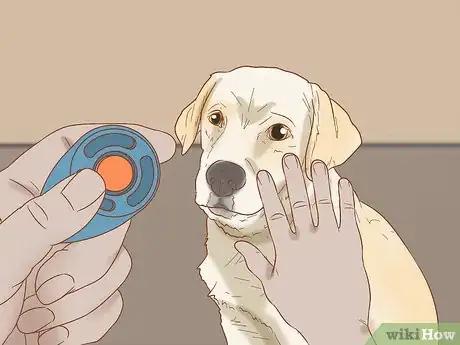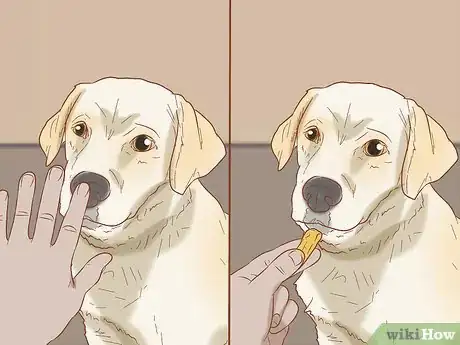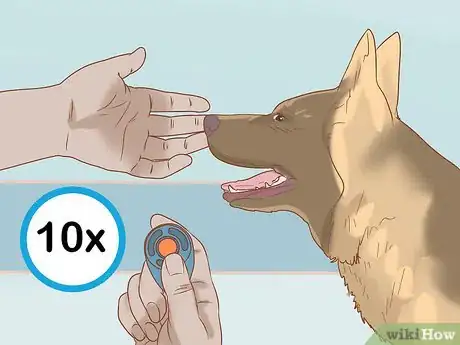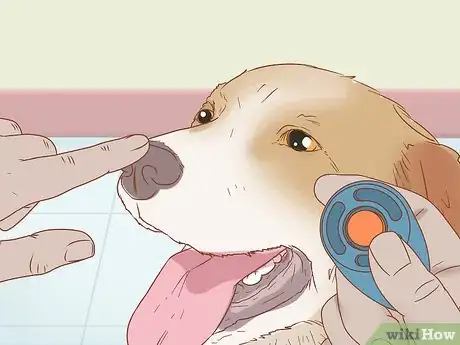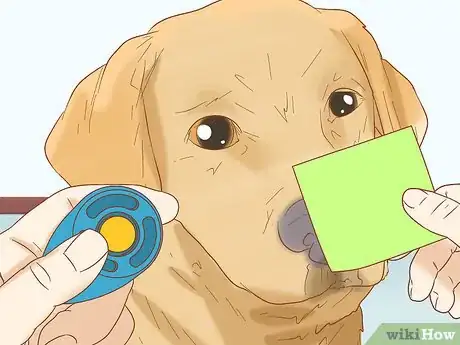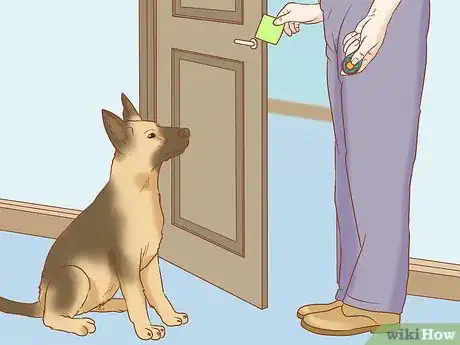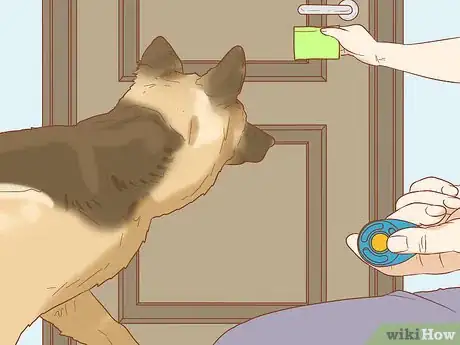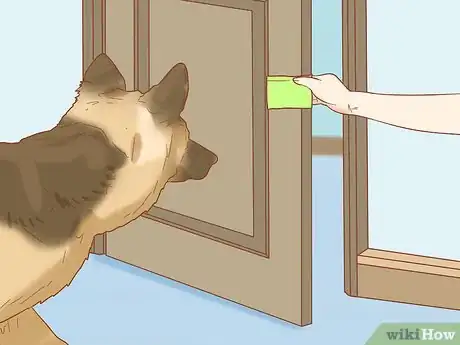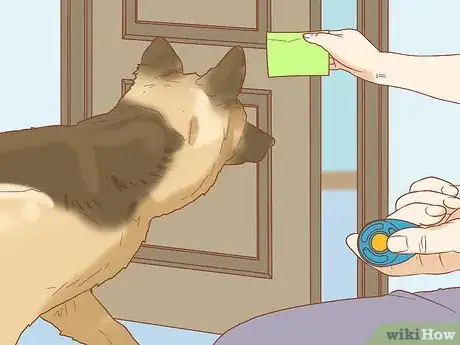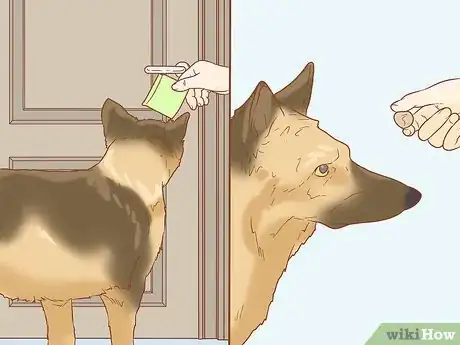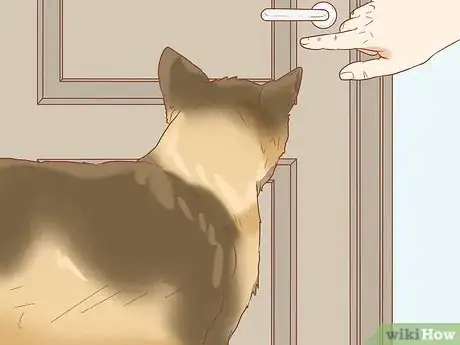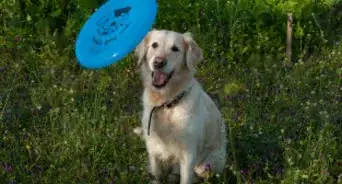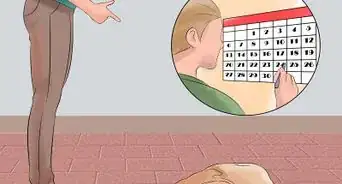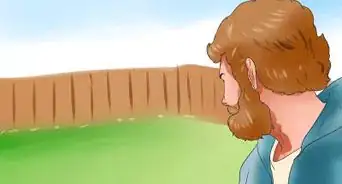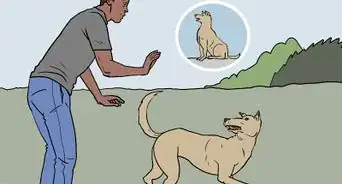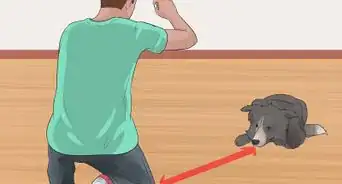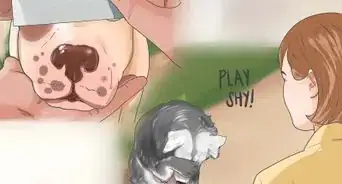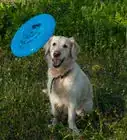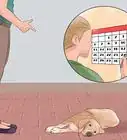This article was co-authored by Beverly Ulbrich and by wikiHow staff writer, Amy Bobinger. Beverly Ulbrich is a Dog Behaviorist and Trainer and the Founder of The Pooch Coach, a private dog training business based in the San Francisco Bay Area. She is a Certified CGC (Canine Good Citizen) Evaluator by the American Kennel Club and has served on the Board of Directors for the American Humane Association and Rocket Dog Rescue. She has been voted the best private dog trainer in the San Francisco Bay Area 4 times by SF Chronicle and by Bay Woof, and she has won 4 "Top Dog Blog" awards. She has also been featured on TV as a dog behavior expert. Beverly has over 18 years of dog behavior training experience and specializes in dog aggression and anxiety training. She has a Master of Business Administration from Santa Clara University and a BS from Rutgers University.
There are 7 references cited in this article, which can be found at the bottom of the page.
This article has been viewed 49,821 times.
Training a dog to close a door is a useful skill that’s surprisingly easy to teach, whether the dog is training to be a service dog or you just want to challenge your pet. However, it is an advanced technique, so before you get started, your dog should already be familiar with clicker training or another similar technique, such as using a verbal marker. Once your dog has mastered that, teach it basic targeting skills before moving on to working with the door.
Steps
Introducing Hand-Targeting
-
1Hold a clicker in one hand and place the other hand in front of the dog. To start target-training your dog, hold your hand flat in front of the dog’s face, with your palm facing its nose. Your hand should be close enough to the dog that it can’t miss you.[1]
- If you've clicker-trained your dog already, you can use a ball-point pen or another item that makes a similar noise to a clicker, if you need to.
- You can also use a verbal marker like “Good” or “Good dog” rather than using a clicker, as long as you do it consistently. Make sure to either click or say your verbal marker every time the dog does what it’s supposed to, and before you give the dog a treat.
-
2Reward the dog if it touches your hand with its nose. If your dog touches your hand with its nose, licks your hand, or brushes its cheek against your hand, click on the clicker and give the dog a high-value treat like diced chicken or hot dogs. At this point, don't worry if the dog perfectly targets your hand with the very end of its nose. You just want the dog to understand the general behavior that you're looking for. [2]
- Praise the dog for any touch, as long as it’s deliberate and it’s not any behavior that you consider rude, like nipping or gnawing on your hand.
Tip: If you’ve taught your dog to shake and it thinks that’s what you’re asking it to do, do this exercise with a closed fist instead of an open hand.
Advertisement -
3Repeat this exercise 10 times in a row. Each time the dog touches its nose to your hand, click and give it a treat. As you progress through the session, be a little more selective about what qualifies for a click. For instance, if the dog only brushed its whiskers against you the first time, by the 5th or 6th time, you might only click if it actually touches you with its nose.
- Keeping the training sessions relatively short will help your dog stay interested.
- If the dog starts to get frustrated or lose interest, cut the training session short and try again a few hours later.
-
4Conduct several training sessions a day for 3-5 days. Training a dog takes a lot of patience and repetition, so don’t try to rush to the next level of training too quickly.[3] Instead, spend several days laying the foundation for hand targeting. Try to spend a few minutes training the dog 2 or 3 times each day, repeating the same gesture about 10 times in each session. Continue to click and offer a treat each time the dog successfully nudges your hand with its nose.[4]
- As the dog gets the hang of hand targeting, give it a challenge by moving your hand slightly just before the dog touches it.
Teaching Your Dog to Touch a Target
-
1Hold a sticky note in your hand to introduce a target. When the dog is consistently responding to the visual cue to touch your hand, it’s time to switch to a target. Hold your target flat in the palm of your hand and encourage the dog to nudge it with its nose, then click, praise the dog, and offer it a treat when it does.[5]
- Sticky notes make a great target because the adhesive makes it easy to transition from targeting your hand to, eventually, the door. However, if you’d prefer to use a different target, that’s fine, as long as you use the same object consistently.[6]
- At this point, it’s helpful to practice your training sessions near the door you want the dog to close.
-
2Repeat the clicker training with the target for several days. Once you introduce the target, do not reward the dog if it nudges your hand instead of the target. Continue having multiple training sessions a day, with about 10 repetitions each time, for 3-5 days. If the dog seems confused about what you expect of it, however, you may need to return to hand targeting for a few days.[7]
- Over the course of your training, gradually move the target so you’re holding with the tips of your fingers, rather than in the palm of your hand.
- Once the dog consistently nudges the target, you can try moving the target to the door.
-
3Move closer to the door gradually, and add a verbal cue. As your training sessions progress, start moving the target closer to the door, and give the dog the verbal command you eventually want to use to tell it to close the door. For instance, you might say “Door,” “Close,” or “Push.” Just be sure to be consistent with whatever word you use.[8]
- You may also want to toss the treat a little away from the door so the dog has to deliberately return to the target each time.
Moving the Target to the Door
-
1Place the target on the door at nose-height and click if the dog touches it. When you’re ready to transition to targeting the door, close the door and attach the target near the edge of the door. Give your verbal cue and tap the target to get your dog to notice it, then praise the dog enthusiastically the first time it touches the target with its nose.[9]
- Even though the door is shut at first, it’s better to pick one spot on the door for the target and use it consistently. By placing the target at the edge of the door, it will be easier for the dog to close it.
- Continue with the same pattern of training—10 repetitions several times a day for 3-5 days until the dog is consistently touching the target on the door.
- If at any point the dog doesn't seem to understand what's going on, go back to the previous training for a few days.
-
2Open the door a little and offer several treats the first time the door moves. Once the dog is very comfortable touching the target on the door, open the door slightly and give it your verbal cue. You may need to tap the target to get the dog to understand that you still want it to perform the same action. However, don’t click or give the dog a treat unless the door moves. When it does, even if it’s only a little, click and praise the dog enthusiastically, then offer several treats to show the dog that’s the result you wanted.[10]
- Consider putting a towel between the door and the frame so it doesn’t slam shut, which might startle the dog.
Did You Know? Teaching a dog to use its nose to close a door can help prevent the dog from accidentally scratching the door or breaking a pane of glass, which can occur if the dog uses its paw.
-
3Continue opening the door a little wider as the dog gets comfortable. If the first training session goes well, open the door 2–3 in (5.1–7.6 cm) wider during the next session. Gradually increase how much you open the door at each training session, and continue to only reward the dog when the door moves.[11]
- As you do this, gradually move farther from the door, but continue to give the verbal command consistently.
-
4Transition to only rewarding the dog when the door shuts. When the dog reliably pushes the door on command, hold back your praise until the door shuts all the way. If the door makes a clicking sound or another noise when it closes, use that as your cue to click and offer a treat. That way, the dog will come to associate the sound of the door closing with the reward.[12]
- This step can take a little patience, but continue consistently working with the dog several times a day until it seems comfortable.
- Leave the target on the door until you’re sure the dog knows that it is supposed to close the door.
-
5Remove the target when the dog masters closing the door. To avoid confusing the dog, wait until it seems very comfortable with the verbal command before you try removing the target. However, if the dog still seems unsure of what to do when you remove the target, try gradually making it smaller instead of moving it all at once.[13]
- For instance, if you used a sticky note, you could cut it in half before a training session. Try a few sessions with the note that size, then cut it in half again. Keep doing this until the target is so small that you can just remove it.
Expert Q&A
-
QuestionWhy isn't my dog learning to close the door?
 Beverly UlbrichBeverly Ulbrich is a Dog Behaviorist and Trainer and the Founder of The Pooch Coach, a private dog training business based in the San Francisco Bay Area. She is a Certified CGC (Canine Good Citizen) Evaluator by the American Kennel Club and has served on the Board of Directors for the American Humane Association and Rocket Dog Rescue. She has been voted the best private dog trainer in the San Francisco Bay Area 4 times by SF Chronicle and by Bay Woof, and she has won 4 "Top Dog Blog" awards. She has also been featured on TV as a dog behavior expert. Beverly has over 18 years of dog behavior training experience and specializes in dog aggression and anxiety training. She has a Master of Business Administration from Santa Clara University and a BS from Rutgers University.
Beverly UlbrichBeverly Ulbrich is a Dog Behaviorist and Trainer and the Founder of The Pooch Coach, a private dog training business based in the San Francisco Bay Area. She is a Certified CGC (Canine Good Citizen) Evaluator by the American Kennel Club and has served on the Board of Directors for the American Humane Association and Rocket Dog Rescue. She has been voted the best private dog trainer in the San Francisco Bay Area 4 times by SF Chronicle and by Bay Woof, and she has won 4 "Top Dog Blog" awards. She has also been featured on TV as a dog behavior expert. Beverly has over 18 years of dog behavior training experience and specializes in dog aggression and anxiety training. She has a Master of Business Administration from Santa Clara University and a BS from Rutgers University.
Dog Behaviorist & Trainer Training a dog takes a lot of patience. It's possible that you just aren't being consistent with your training. Try to maintain the same expectations and standards while you're working with your pup. Every dog can learn. It's just a question of being patient and sticking with it.
Training a dog takes a lot of patience. It's possible that you just aren't being consistent with your training. Try to maintain the same expectations and standards while you're working with your pup. Every dog can learn. It's just a question of being patient and sticking with it. -
QuestionHow long does the process take?
 Community AnswerIt depends on how intelligent the dog is. If he/she learns quickly, it may take three to four days.
Community AnswerIt depends on how intelligent the dog is. If he/she learns quickly, it may take three to four days. -
QuestionI'm using a post it note, what if my dog is biting the target instead of touching it?
 Community AnswerTry putting apple cider vinegar on it, or maybe lemon juice. You could also try taping all of the edges to the door.
Community AnswerTry putting apple cider vinegar on it, or maybe lemon juice. You could also try taping all of the edges to the door.
Things You’ll Need
- Clicker
- High-value treats like diced chicken
- Target (e.g. sticky notes, container lid and double-sided tape, etc)
References
- ↑ https://www.whole-dog-journal.com/issues/16_11/features/teach-dog-chores-around-house_20862-1.html
- ↑ https://www.whole-dog-journal.com/issues/16_11/features/teach-dog-chores-around-house_20862-1.html
- ↑ Beverly Ulbrich. Certified Dog Trainer. Expert Interview. 30 January 2020.
- ↑ https://www.anythingpawsable.com/teach-a-service-dog-to-close-a-door/
- ↑ https://youtu.be/4lL3Js-E1Bc?t=45
- ↑ https://www.whole-dog-journal.com/issues/16_11/features/teach-dog-chores-around-house_20862-1.html
- ↑ https://youtu.be/4lL3Js-E1Bc?t=45
- ↑ https://youtu.be/4lL3Js-E1Bc?t=87
- ↑ https://www.anythingpawsable.com/teach-a-service-dog-to-close-a-door/
